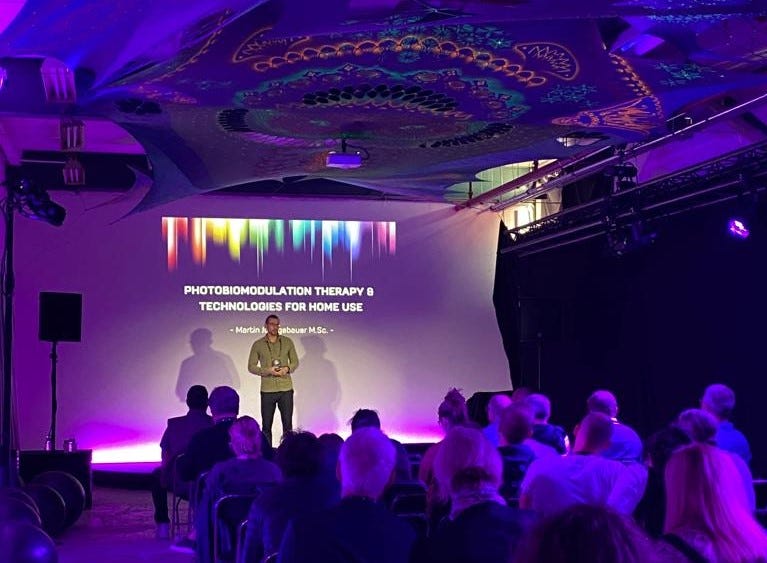Photobiomodulation beyond its transcranial application
Mapping the field: Ultraviolet, blue, and green light PBM; Photodynamic Therapy; and PBM in home use
Summary
PBM is much more than just red and infrared light therapy. State-of-the-art technology facilitates the application of ultraviolet, blue, green, and yellow light, which have beneficial health effects beyond those delivered by red and infrared light. An important distinction has to be made between Photobiomodulation (PBM) and Photodynamic Therapy (PDT). PBM, in simplified terms, regenerates, activates, and stimulates cells and tissue. PDT, on the other hand, can be used to selectively destroy target cells such as viruses, bacteria, parasites, fungi, and even some kinds of cancer. I further emphasize that PBM is not only used in medical settings but that there is also solid evidence for its effectiveness in home use.
Light penetration into the human body
So far, we explored the transcranial application of Photobiomodulation to improve neurological and mental health. There, we use infrared light because it can penetrate through the skin, blood vessels, cranium, and all other tissue components to reach the brain eventually. However, because these biological tissues absorb light, a lot of the energy is lost on its way. If you care about the math, a ballpark number is that approx. 3% of the light we apply on the skull reaches a depth of 5cm.
Now, recall the colors in a rainbow for a moment.
The colors at the bottom of the rainbow, such as ultraviolet and blue, have the – in technical terms – shortest wavelengths. The higher you look up the rainbow, the longer the wavelengths of the colors you see. There is a general rule regarding light penetration into the human body: The longer the wavelength, the better and deeper the penetration into the human body. What you see on the very top of the rainbow is infrared light, just beneath it is red light. These two colors have the highest penetration depth of all the rainbow colors. That is why photobiomodulation is so often referred to as “infrared therapy” or “red light therapy” – you can apply these two colors on the skin and they will have beneficial effects not only on the skin itself but also in deeper layers of the body. While infrared reaches depths of approx. 5cm, red light only penetrates 2-3cm. The precise penetration depends on many factors, such as the site of application, the skin color of the patient (darker skin absorbs more red and infrared light than lighter skin), the kind of tissue that has to be passed (ratio of fat and muscles for example), the technical details of the light beam (for example how focused it is) - all that and more matters. Yellow and green light are still able to penetrate approx. 0.5cm into tissue, blue light a bit less, and ultraviolet almost not at all.
Ultraviolet, blue, and green light PBM
At this point, state-of-the-art laser technology such as the Endolaser system by Weber Medical comes in. Such medical systems facilitate minimal-invasive applications of therapeutic light dosages in all parts of the human body. They allow physicians to pass the skin and apply the light directly in our bloodstream, joints, or the interstitial area. Basically in all parts of our body, except for inner organs. That has opened the door to moving photobiomodulation beyond its topical application with red and infrared light.
Ultraviolet light is well-known for its effectiveness against pathogens. Who doesn´t know UV sterilization boxes from daily life? Most people are also familiar with UV water purifying systems. There are also UV blood purifying systems that free blood samples from pathogens, such as the FDA-approved MIRASOL system.
While research on yellow light is still in its infancy, there is already a systematic literature evaluation for blue and green light, reporting that 72% resp. 75% of publications reported beneficial effects of blue light resp. green light PBM. As usual, I want to share a link if you care about a deep dive into the topic, and specifically into the mechanisms of blue and green light PBM:
https://www.ncbi.nlm.nih.gov/pmc/articles/PMC6685747/
Certainly, a lot of research still needs to be done to identify the ideal protocols and applications for the shorter-wavelength colors (and also for red and infrared PBM). Still, the key takeaway from what we currently understand is that there is much therapeutic potential that has so far only very partially been explored. PBM is much more than just red and infrared light therapy.
Photobiomodulation vs. Photodynamic Therapy
To further map the field, it is essential to differentiate between Photobiomodulation (PBM) and Photodynamic Therapy (PDT). As you read before, we can use PBM to regenerate, activate, and stimulate cells and tissue. PDT, on the other side, can be used to selectively destroy target cells such as viruses, bacteria, parasites, fungi, and potentially also cancer. The latter application is FDA-approved for the treatment of certain skin cancers and also promising for the treatment of internal cancers. However, treatment results for internal cancers are unstable and it is too early to make validated statements at this moment. Its application to infections will be the subject of the next post as we very recently published a study in which we successfully used UV and blue light photodynamic therapy to treat Malaria patients. Focussing on the basic differentiation for now, we, by definition, use photosensitizers (non-toxic dyes that can come in different forms, but most commonly as IV infusions) in PDT. These photosensitizers can be activated by absorption of light with specific wavelengths. Which wavelength depends on the photosensitizer, or more precisely, its absorption band. Once activated, the photosensitizer undergoes photophysical reactions with oxygen to form reactive oxygen species (including singlet oxygen) that can oxidize biomolecules and destroy cells. Using this principle, PDT can be used to treat localized infections.
I recently gave a presentation about the general mapping of the whole field of PBM at the Biohacking Summit in Amsterdam, which took place between the 14th and 15th of October. For those who haven´t heard about biohacking before – it is the practice of using all kinds of biological, genetic, neuroscientific, and nutritional methods (or “hacks”) to improve overall health and well-being, or, more specifically, enhance physical and mental performance. These hacks are typically done at home, not in medical settings. That brings me to the last part of this overview on PBM beyond its transcranial application.
Medical Photobiomodulation vs. Photobiomodulation in home-use / as a biohack
PBM is not only applicable as a medical treatment but also as a biohack / as a beneficial health intervention from the comfort of your home. Being effective as a medical treatment does not automatically mean that the respective intervention is also effective in home use. However, there is a huge number of studies on home use PBM consistently showing good effects. Here is a review of the studies published until 2018. Bottom line: “Home-use PBM devices appear to mediate effective, safe treatments in a variety of conditions that require frequent applications.”
https://pubmed.ncbi.nlm.nih.gov/30418078/
Related to this, I am ending this substack with a quick word on my own account. I try to keep this substack as neutral and unbiased as possible, but I do make my living being a business partner to companies that produce science-based integrative medical technology and equally evidence-based biohacks. If you care about using PBM in home use yourself, check out the products by W Medical System, specifically the Endolight Band. It uses blue, green, red, and infrared lasers, as well as a yellow LED diode, to irradiate the blood in the two main arteries that run very close to the surface of the wrist. Due to the arteries´ proximity to the surface, the light of the shorter wavelengths (blue, green) also reaches the blood. First data shows that it can improve regional oxygen saturation, support relaxation and recovery by increasing parasympathetic nervous system activity / decreasing sympathetic activity (so far unpublished data but available upon request), and improve performance in weightlifting and running (so far unpublished data but available upon request), Use the code “Martin191023“ at check-out if you decide to order a product. It will give you a 10% discount.
Disclaimer
I am not a medical professional, and the above is not meant as medical advice; I am merely sharing my personal understanding of the subject.
How to obtain more information?
Simply make contact with me - best through LinkedIn or email - to obtain more information about all the above.
Resources
- Pathogen Reduction Technology Treatment of Platelets, Plasma and Whole Blood Using Riboflavin and UV Light
https://www.ncbi.nlm.nih.gov/pmc/articles/PMC3132976/
- Under the spotlight: mechanisms of photobiomodulation concentrating on blue and green light.
https://www.ncbi.nlm.nih.gov/pmc/articles/PMC6685747/
- Therapeutic Efficacy of Home-Use Photobiomodulation Devices: A Systematic Literature Review
https://pubmed.ncbi.nlm.nih.gov/30418078/
- Laser Watch—New Generation 2021: Modern Integrative Photomedicine Equipment for Photobiomodulation




